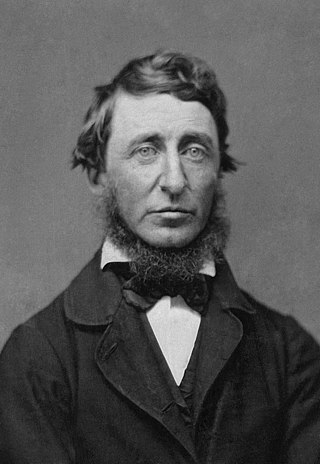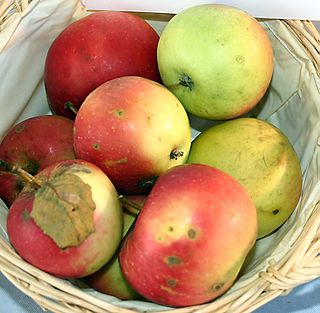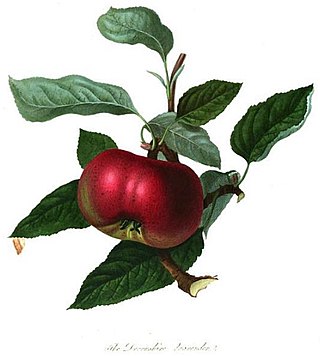
The 'Blue Pearmain' is an American apple variety, mentioned by Henry David Thoreau in his 1862 essay "Wild Apples."

The 'Blue Pearmain' is an American apple variety, mentioned by Henry David Thoreau in his 1862 essay "Wild Apples."
The Blue Pearmain's origin is uncertain, but it was known in the US, and widely planted near Boston, in the early 1800s. [1] [2]
Henry David Thoreau describes picking and eating "Blue-Pearmain" apples in his 1862 essay "Wild Apples." [3] [4]
In the late 19th century, the Blue Pearmain won some recognition in England, receiving "an Award of Merit from the Royal Horticultural Society in 1893 and a First Class Certificate in 1896," according to the website of the United Kingdom's National Fruit Collection.
The apple is large, typically round, with a thick red skin stippled with dots and overlaid by the characteristic blue bloom that gives the variety its name. [2] According to Rowan Jacobson in his book Apples of Uncommon Character: [5]
..the look of the Blue Pearmain is half the pleasure. It starts in September as an impressionist’s masterpiece of swirling reds, oranges, and yellows, then, as fall goes by, it deepens into a dark burgundy with blackish streaks and a powdery blue bloom over the surface, as if night was falling and the last colors were draining from the sky.
Jacobson describes the Blue Pearmain's flavor as "all pear and melon and fig, with a touch of hard-charging kiwi brightness to keep things from getting cloying". [5] The apple can be used for fresh eating or for cider or baking. If stored for more than two months, the apples tend to shrivel. [6]

Henry David Thoreau was an American naturalist, essayist, poet, and philosopher. A leading transcendentalist, he is best known for his book Walden, a reflection upon simple living in natural surroundings, and his essay "Civil Disobedience", an argument for disobedience to an unjust state.

Amelanchier, also known as shadbush, shadwood or shadblow, serviceberry or sarvisberry, juneberry, saskatoon, sugarplum, wild-plum or chuckley pear, is a genus of about 20 species of deciduous-leaved shrubs and small trees in the rose family (Rosaceae).

Golden Delicious is a cultivar of apple. It is one of the 15 most popular apple cultivars in the United States. It is not closely related to Red Delicious.

Malus is a genus of about 30–55 species of small deciduous trees or shrubs in the family Rosaceae, including the domesticated orchard apple, crab apples and wild apples.

Sorbus is a genus of over 100 species of trees and shrubs in the rose family, Rosaceae. Species of Sorbus (s.l.) are commonly known as whitebeam, rowan (mountain-ash) and service tree. The exact number of species is disputed depending on the circumscription of the genus, and also due to the number of apomictic microspecies, which some treat as distinct species, but others group in a smaller number of variable species. Recent treatments classify Sorbus in a narrower sense to include only the pinnate leaved species of subgenus Sorbus, raising several of the other subgenera to generic rank.

Malus domestica is a cultivar of apple that is usually eaten cooked due to its sourness. The variety comes from a pip planted by Mary Ann Brailsford. The Concise Household Encyclopedia states, "Some people eat this apple raw in order to cleanse the palate, but Bramley's seedling is essentially the fruit for tart, pie, or dumpling." Once cooked, however, it has a lighter flavour. A peculiarity of the variety is that when cooked it becomes golden and fluffy. Vitamin C 15mg/100g.

The damson or damson plum, also archaically called the "damascene", is an edible drupaceous fruit, a subspecies of the plum tree. Varieties of insititia are found across Europe, but the name damson is derived from and most commonly applied to forms that are native to Great Britain. Damsons are relatively small ovoid plum-like fruit with a distinctive, somewhat astringent taste, and are widely used for culinary purposes, particularly in fruit preserves and jams.

The Haralson is a cultivar of apple that is medium-sized and has a round-conic shape.

The Jonathan apple is a medium-sized sweet apple, with a touch of acid and a tough but smooth skin. It is closely related to the Esopus Spitzenburg apple, good for eating fresh and for cooking.

Esopus Spitzenburg or Aesopus Spitzenburgh is a variety of apple. It was discovered early in the 18th century near Esopus, New York and is reputed to have been a favorite apple of Thomas Jefferson, who planted several of the trees at Monticello.

An apple is a round, edible fruit produced by an apple tree. Apple trees are cultivated worldwide and are the most widely grown species in the genus Malus. The tree originated in Central Asia, where its wild ancestor, Malus sieversii, is still found. Apples have been grown for thousands of years in Asia and Europe and were introduced to North America by European colonists. Apples have religious and mythological significance in many cultures, including Norse, Greek, and European Christian tradition.

'Worcester Pearmain' is an early season English cultivar of domesticated apple, that was developed in Worcester, England, by a Mr. Hale of Swanpool in 1874. It was once the most popular cultivar in England for early autumn harvest and is still popular to keep in the garden. It has been extensively used in apple breeding.

'Alkmene' is a German cultivar of domesticated apple, also called 'Early Windsor'.

Ellison's Orange is an English cultivar of domesticated apple, it is a cross between the famous Cox's Orange Pippin and Cellini, which it resembles at most in looks and taste, but can develop a distinct aniseed flavor in storage. The variety is much more disease resistant than Cox's and therefore easier to cultivate.

Golden Russet is an old American cultivar of domesticated apple which is excellent for fresh eating as well as for apple cider production. It is a russet apple and is therefore especially used as a cider apple. It is sometimes known as 'English Golden Russet', and has frequently been confused with 'English Russet'.

Winston is an English cultivar of domesticated apple which was first named Winter King because of its availability in the winter, but was renamed as Winston in 1944 or in 1945, after Winston Churchill.

Grenadier is an English cultivar of domesticated apple mainly used for cooking. It originated in the mid-19th century in Buckinghamshire. It was first recorded in 1862 in Maidstone, Kent, exhibited by Charles Turner of Slough, Berkshire, and then commercially introduced by Bunyard Nursery.

Dumelow's Seedling is a cultivar of domesticated apple that originated at Shackerstone in Leicestershire where it was grown by Richard Dumeller in 1800. It is known by many other names including 'Dumelow's Crab', 'Wellington', 'Doncklaer', 'Beauty', and 'Belle de Vennes'. The fruit is not ready for harvest until October, being one of the last of the season, and keeps well into the next year. Though inferior for use as a dessert apple it cooks well and in early-20th century England was one of the most valuable varieties of cooking apple.
The costard was a variety of apple popular in medieval England, and the second apple variety introduced by the Normans. It was grown widely as a commercial crop by the 13th century and was supplied to the household of Edward I in 1292. It remained widespread for several hundred years, until other apple varieties gained popularity during the 17th century. It is thought to have been a cooking apple and was perhaps similar to the modern Bellflower apple. It is said to have been named for its resemblance to the human head.

The Devonshire Quarrenden is a dessert apple cultivar historically grown and probably originating in England, although it has also been suggested as originating in France. A variety of local names and spellings, including "Red Quarrenden", "Quarrington", "Quarender", and the "Sack Apple", have been recorded in the past.
Thought to have originated in U.S.A. It was known in the early 1800s. Received an Award of Merit from the Royal Horticultural Society in 1893 and a First Class Certificate in 1896. Fruits have somewhat dry, rather soft, coarse-textured flesh with a sweet, pleasant aromatic flavour.
The fruit is of mild flavor and does not rank high in quality. The skin is thick. When well colored it is beautiful, though not brilliant, being overcast with a dull bluish bloom. In common storage it does not keep late, and by January it often becomes shriveled (18). It is not a good market fruit and is not recommended for commercial planting
"For I do not refuse the Blue-Pearmain, I fill my pockets on each side; and as I retrace my steps in the frosty eve, being perhaps four or five miles from home, I eat one first from this side, and then from that, to keep my balance.' -Thoreau, 'Wild Apples'
I know a Blue-Pearmain tree, growing within the edge of a swamp, almost as good as wild.
The Blue Pearmain is one of the classic old-timey New England apples. A taste of one will make you realize how threadbare our popular apples have become when it comes to interesting flavors.
Cold Storage: Keeps up to two months in cold storage but tends to shrivel which gives the apple unappetizing appearance though the flavours become more concentrated and intense.